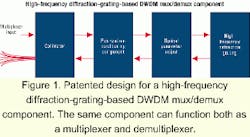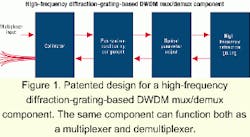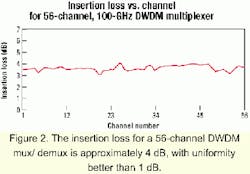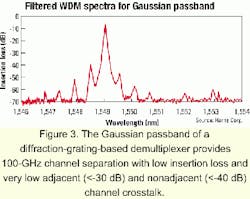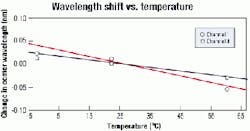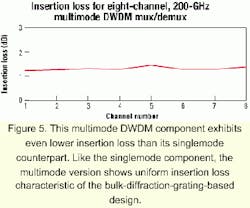Bulk diffraction gratings play increasing role in optical networking
New components based on these gratings will provide a useful alternative for DWDM mux/demux applications.
DR. W. TIM BOORD, TERRY L. VANDERWERT, APA Optics, and DR. RICHARD DeSALVO, Atlantic Photonics Inc.
New design technology for DWDM multiplexer/demultiplexer components is facilitating the growth of DWDM network systems. Coupled with the development of new test and measurement equipment used in the manufacture of these optical components, bulk diffraction technology is taking the spotlight because of its ability to support new applications for optical communications. In particular, these components help to meet the demands of today's bandwidth explosion through their ability to support narrow channel spacing, high channel counts, singlemode- and multimode-fiber applications, and adding and dropping a large number of wavelengths.
A diffraction grating is a row of fine parallel lines, usually on a reflective surface. Lightwaves bounce off the lines at angles dependent on their wavelengths, so light reflected from a diffraction grating spreads out in a spectrum. (The same effect is seen by reflecting light from a CD, where the lines spiral very tightly around the reflective disk.)
Thus, the heart of DWDM mux/demux components based on bulk diffraction gratings is a diffraction grating with a number of fine, equally spaced grooves. The various wavelengths of a multiwavelength light-source incident onto the grating surface are dispersed, or diffracted, at precise angles, based on the wavelength and angle of incidence.When the component is functioning as a multiplexer, multiple input beams (wavelengths) are directed from their individual fibers onto the grating. The grating is oriented at a precise angle so that all wavelengths are diffracted onto a common output fiber.
These new components can also function as a demultiplexer, where the combined wavelengths entering from the common fiber are diffracted into individual wavelengths by the grating and coupled into separate fibers.
Bulk diffraction grating technology is gaining recognition as a result of (1) the growing demand for higher channel counts with narrower spacing and a recognition that this technology provides high-quality solutions and (2) the availability of smaller package sizes consistent with the need of network designs.
In the past, diffraction-grating-based components required large packages, a feature inconsistent with one of the inherent advantages of optical networks. Low-frequency (<400 lines/mm) gratings were required to achieve high diffraction efficiency (for low insertion loss) independent of the polarization condition of the laser light. However, the low dispersion of these coarse gratings required relatively long focal-length focusing optics, which in turn increased the size of the component package.This packaging problem has been solved using a high-frequency diffraction grating. An optical component that conditions the input polarization, independent of orientation, for maximum diffraction efficiency and minimum polarization-dependent loss (PDL) is added to compensate for the inherent polarization dependence of the high-frequency grating (see Figure 1).
Diffraction-grating-based components are gaining recognition for their optical performance flexibility with respect to the number and range of muxed/demuxed wavelengths and their ability to provide a path for increasing the number of channels used by the optical network. These components are found in a wide range of DWDM system and subsystem designs for long-haul, metropolitan, and enterprise networks, including cable TV. Following is a summary of the performance characteristics of diffraction-grating-based mux/demux components, including a discussion of design tradeoffs.Insertion loss. A measure of the power lost through the component, insertion loss affects the fiber-optic communication system requirements. Low insertion loss influences network design and economics by providing designers greater margin and reducing or sometimes eliminating amplification costs.
Since separating and combining wavelengths with a diffraction grating is a "parallel" process, insertion loss is nearly independent of the number of channels. The relatively low insertion loss achieved for channel counts as low as eight is also achieved for high-channel-count components (see Figure 2). In addition, the insertion loss is uniform (generally within 1 dB) even for high channel counts.
Passband. The passband of diffraction-grating-based components can be tailored to the requirements of a particular network architecture. These components are probably best known for their Gaussian-shaped passband, which exhibits the lowest insertion loss at the passband center wavelength. The disadvantage of this shape is that insertion loss is sensitive to laser drift. Also, the passband center-wavelength error further reduces the system passband when two or more mux/demux modules are incorporated in the fiber-optic link.
However, the Gaussian-shaped passband has application at transmission terminal points:
- WDM transmission terminals. When optical-amplifier power boosters are used, the low insertion loss makes efficient use of the amplifier gain. The narrow bandwidth of the Gaussian-shaped passband also helps deliver high optical signal-to-noise-ratio (OSNR) DWDM channels to the link.
- Optically Amplified Receivers. The low insertion loss and narrow bandwidth of the demultiplexer contribute to the high sensitivity offered by an optically preamplified receiver (see Figure 3). While 10-Gbit/sec transmission requires an additional 6 dB of transmitted power to provide the required bandwidth, fiber nonlinearities place a limit on the power that can be transmitted over the fiber-optic link. Therefore, to avoid system performance degradation resulting from fiber nonlinearities, optical preamplifiers are typically placed before the receiver to amplify the signal and provide the additional 6 dB. The low insertion loss of the diffraction-grating demultiplexer preserves the precious, preamplified signal intensity, while the Gaussian passband minimizes the amplified spontaneous emission beat-noise terms delivered to the optical receiver.
Figure 4. Wavelength shift versus temperature for an eight-channel, 200-GHz mux/demux component. The wavelength shift shown above is <1.5 pm/°C.
The flat-top passband minimizes the passband narrowing that occurs with the cascading of several mux/demux modules and provides a margin for the time- and temperature-related drift of the center wavelength of other network system components.
Crosstalk. Diffraction-grating-based designs are known for their low adjacent- channel (<-25 dB), nonadjacent-channel (<-30 dB), and total crosstalk. The new diffraction-grating-based components can provide isolation to levels that enable new applications. For example, in cable-TV applications, adjacent-channel crosstalk has been tailored to <-30 dB to maintain the required OSNR.
Temperature sensitivity. Diffraction-grating components can be designed to be athermal, thereby requiring no active temperature contol. That simplifies system design by avoiding the need for power, alarms, and monitoring associated with components that require active temperature control (see Figure 4).
But singlemode components are not the only application for bulk diffraction gratings. New applications such as Gigabit Ethernet and 10-Gigabit Ethernet have created the need for DWDM components based on 62.5- and 50-micron-core multimode fiber. With the new diffraction-grating-based designs, both the insertion loss is lower (<3 dB) and the adjacent-channel crosstalk is lower (<-30 dB) than for the singlemode counterpart (see Figure 5). Other optical and environmental performance factors are similar to the singlemode component.
The manufacturability of bulk diffraction optical components is a key factor in determining their adoption in networks. To facilitate manufacturability, singlemode and multimode models share a common design. Such a platform-based design provides for re-use of components between models and leverages investments in assembly processes and equipment across the entire product line. To ensure the level of quality discussed, bulk diffraction optical components are manufactured using processes that employ precision fixturing and automated laser welding.Setting of the wavelength range to be muxed/demuxed by the component is one of the last operations in the assembly process. Since the wavelength can be specified late in the assembly process, the user of the component has additional time and flexibility in assigning the wavelengths as a tool for better inventory management.
This same flexibility also means that the mux/demux module can be aligned to any wavelength range within the S-, C-, or L-band. These wavelengths may be on the ITU wavelength grid or offset by any specified amount within the resolution of the wavelength meter.
In addition to integration in new systems, the new diffraction-grating-based mux/demux modules are ideally suited for upgrading field-installed systems for the following reasons:
- No active temperature control is required, nor are the power and monitoring associated with such temperature control.
- Fiber management-input and output fibers enter and exit from the same location.
- The compact footprint integrates easily into existing systems.
Diffraction-grating technology as applied to DWDM mux/demux components is uniquely capable of addressing existing and emerging optical-networking requirements. The key benefits and applications for diffraction-grating components have been identified and proven through collaboration and system-level testing with initial users.
Dr. W. Tim Boord is an applied research and development scientist in the fiber-optics group and Terry L. VanderWert is general manager of fiber-optic products at APA Optics (Blaine, MN).
Dr. Richard DeSalvo is president of Atlantic Photonics Inc. (Satellite Beach, FL). They can be reached at their respective e-mails: [email protected], [email protected], and [email protected]. The authors wish to thank Harris Corp. and particularly Scott Bricker for providing performance data related to application of Harris's 10-Gbit/sec optically preamplified receiver.
